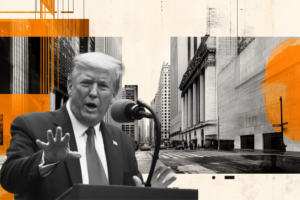This as-told-to essay is based on a conversation with Bayard Winthrop, founder and CEO of California-based apparel-maker American Giant. The interview has been edited for length and clarity.
I’ve had a career of running small consumer product manufacturing businesses.
Early on, I had really taken the Chicago School libertarian economic thinking to heart. I felt that all trade was good trade, and that moving manufacturing overseas was what you did, and made financial sense, so I followed that script.
Over time, what began to dawn on me is that I was becoming increasingly disconnected from the product that I was selling, and I really hated that feeling.
I also hated that I would work with these people that helped me stand the business up and then, because I could get a part that was stamped for 10 or 15 or 20 cents cheaper, I could cut my labor rates.
When I had my first daughter in 2010, I just didn’t want to do it anymore. I got this pretty naive notion to start American Giant.
I grew up in the 70s and 80s with the great American clothing brands like Levi’s and Wrangler and Champion and Red Wing and Woolrich. Not only did they make the best products and clothing in the world, but I also felt that they said something about me when I wore them. They were substantive.
By 2010, there were no clothing brands like that anymore. They’d all shipped overseas.
I launched with a men’s sweatshirt, because I was just interested in that category, and a news article called it “the greatest hoodie ever made.”
That article just went crazy. It tipped us into a back-order status for almost three years, and it convinced me that there was a real consumer demand for this.
The last 40 years have been really bad for the working middle class
When you live in a place like San Francisco, where I do, and you’re surrounded by people with college degrees, like I have, and you’ve been in the stock market, life looks pretty good.
But if you’ve been living in a rural or urban community, and you have a high school degree, and you don’t own stocks, the last 40 years have been really bad. I think that sets up a bad framework for the country, and I think we’ve got to do something about it.
American Giant was my small way of trying to build a business that I felt was contributing and was doing the right thing.
With the textile industry in particular, the US basically took a very robust, rapidly modernizing industry and basically stopped it in its tracks.
In 1970, something like 95% of all clothing bought by Americans was made in America. Now it’s less than 5% so the bottom is falling out of that market.
What has been left is a very kind of disaggregated supply chain, meaning you’ll have a yarning operation here, a dying and finishing operation there, a knitting operation there. If you want to have production domestically, you have to support all of that separated and atomized production, and that just makes it harder.
In China, you can go and say you need 100,000 purple T shirts with frills on the sleeves, and you’ll have 20 factories bidding.
We had to really get into the supply chain, assemble it ourselves, in many cases, and hold it together. It’s gotten a lot easier now because our volumes have grown and now we’re not the only people doing it.
It’s harder and it’s more expensive, but I think the quality is a lot higher because you can just get a lot closer to the source. It’s definitely not the easy way.
There’s a lot of misunderstanding about what’s possible here
You can absolutely, particularly in knitwear, make very high-quality, very large volume knitwear in the United States — most companies have just forgotten how to do it.
Instead, we have trade agreements that are in varying degrees of bad or less than ideal. I think China is squarely in the zone of really bad.
US trade needs to get fundamentally reset.
Trump’s tariffs have shoved that entire conversation into the middle of the country, which I think is a good thing.
The country is finally having robust conversations in DC and on Main Street about what is wrong with our trading relationships and what needs to get fixed. This was not part of the national discourse eight years ago. It is now.
The fact that we are aggressively targeting, in my judgment, China is a good thing.
As the pandemic showed, if they turn off supplies like medical masks or medical gowns, it’s very bad for the country, and it puts the country at risk.
On the other hand, I think that the way that the administration has been communicating this has been very disjointed.
People say Trump is a master negotiator, and that all may be true, but for private businesses big and small, it is very destabilizing. When private sector businesses feel like things are unpredictable or unstable, that freezes capital and people stop moving — and stop investing.
There are going to be supply chain ramifications for the current approach, and so the speed at which it plays out is going to be challenging.
There are still many, many things that we rely on China completely for, like pipe fittings, that we take for granted and make the economy work. What happens if those become two or three times more expensive to small, medium, and large businesses that supply our plumbers?
I don’t like the instability. I don’t like the threat of the speed and the breadth of this stuff. And I certainly don’t think that we ought to be treating, you know, our friendly allies, like, let’s say Canada and Vietnam, the same way we’re treating China.
Those are very, very different situations, and ought to be treated as such.
The United States was the knitwear capital of the world for a very long time
The US is still a net exporter of cotton.
Our primary yarn supplier is a net exporter of yarn. There is plenty of cotton and yarn to handle whatever business we could throw at the US supply chain. Dying and finishing capacity would be fine. It’s really at the very end — the sewing, which is the most manual step in the process — that would take some time to spin up.
We now have a T-shirt program at Walmart that is very large volume, and we’ve had no problem meeting that demand, and it could quadruple overnight fairly easily. And that’s just little old American Giant.
So there’s plenty of knit capacity here, and plenty of cotton and yarn capacity to handle any kind of increase in volume.
Much of textile machinery is coming from Korea, Japan, Germany, Switzerland, and Italy, which raises an interesting question: Why is it coming to the United States versus being made here?
The skills gap question is also a really interesting one. We don’t have people who want to fill some of these jobs.
How do we convince people to come over here instead of working at a fast-food restaurant? We’ll train you to seamstress, we’ll give you 40 or 50 hours a week, you could learn a lot, you can grow. I think that will happen, it just will take a bit of time to respond.
Rebalancing trade will involve some trade-offs
I am a believer that if the net effect of these tariffs are that we do have to pay a bit more for a T shirt and that results in increased labor rates for people that are living in places like Middlesex, North Carolina, I’ll take that trade-off.
The speed at which this is all happening, however, I think that’s going to create some problems.
My hope is that there is this shift toward better-quality stuff made closer to home that provides good, viable work to people that need it. If the effect of that is that average Americans need to begin to be a bit more conscious of how they’re consuming, I’ll take that trade.
This shouldn’t become such a crystallized, polarized discussion. It should matter to all of us as Americans. We can’t build a country that has half the country in the stock market and doing great, and the other half struggling to find work. It just doesn’t work.
We’re not going to rewind the clock to the 80s, and we’re not going to revert back to a place where everything that we consume is made here.
But between there and where we are now, there is a more rational middle ground that I think will reinject some vitality back into these communities that need work.
Read the full article here
















